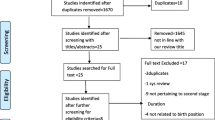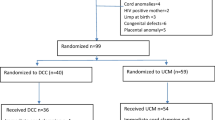Abstract
Objective
To investigate whether vacuum extraction due to failure of labor to progress (dystocia) during the second stage in a delivery following a previous cesarean section (CS) is related to increased adverse maternal and perinatal outcomes as compared with repeated CS.
Study design
A retrospective cohort study of pregnancy and delivery outcomes of patients in their second deliveries attempting a vaginal birth after cesarean (VBAC) following one CS was conducted. Patients who delivered by vacuum extraction were compared with patients who underwent a repeated CS for failure of labor to progress during the second stage.
Results
During the study period, 319 patients with a previous CS suffered from a prolonged second stage of labor in their second delivery. Of these, 184 underwent vacuum extraction and 135 patients underwent a repeated CS. No significant differences in relevant pregnancy complications such as perineal lacerations, uterine rupture, and post-partum hemorrhage and perinatal outcomes were noted between the groups. There were no cases of perinatal mortality in our study.
Conclusion
When managing second stage labor disorders, vacuum extraction does not seem to be an unsafe procedure in patients with a previous CS.
Similar content being viewed by others
References
MacDorman MF, Declercq E, Menacker F (2011) Recent trends and patterns in cesarean and vaginal birth after cesarean (VBAC) deliveries in the United Sates. Clin Perinatol 38:179–192
National vital statistics reports—births: final data for 2008, published 8 Dec 2010, Vol 59, No. 1, NCHS, CDC
Bailey PE (2005) The disappearing art of instrumental delivery: time to reverse the trend. Int J Gynaecol Obstet 91(1):89–96
McMahon MJ, Luther ER, Bowes WA, Olshan AF (1996) Comparison of a trial of labor with an elective second cesarean section. N Engl J Med 335:689–695
Lydon-Rochelle M, Holt VL, Easterling TR, Martin DP (2001) Risk of uterine rupture during labor among women with a prior cesarean section. N Engl J Med 345:3–8
Landon MB, Hauth JC, Leveno KJ et al (2004) Maternal and perinatal outcomes associated with a trial of labor after prior cesarean delivery. N Engl J Med 351:2581–2589
Phillips E, McGrath P, Vaughan G (2010) ‘I wanted desperately to have a natural birth’: mothers’ insights on vaginal birth after caesarean (VBAC). Contemp Nurse 34:77–84
Majoko F, Gardener G (2008) Trial of instrumental delivery in theatre versus immediate caesarean section for anticipated difficult assisted births. Cochrane Database Syst Rev (4). doi:10.1002/14651858.CD005545.pub2
Contag SA, Clifton RG, Bloom SL, Spong CY, Varner MW, Rouse DJ, Ramin SM, Caritis SN, Peaceman AM, Sorokin Y, Sciscione A, Carpenter MW, Mercer BM, Thorp JM Jr, Malone FD, Iams JD (2010) Neonatal outcomes and operative vaginal delivery versus cesarean delivery. Am J Perinatol 27(6):493–499
Friedman EA (1954) The graphic analysis of labor. Am J Obstet Gynecol 68:1568–1575
Feinstein U, Sheiner E, Levy A, Hallak M, Mazor M (2002) Risk factors for arrest of descent during the second stage of labor. Int J Gynaecol Obstet 77(1):7–14
Ebulue V, Vadalkar J, Cely S, Dopwell F, Yoong W (2008) Fear of failure: are we doing too many trials of instrumental delivery in theatre? Acta Obstet Gynecol Scand 87(11):1234–1238
Silberstein T, Wiznitzer A, Katz M, Friger M, Mazor M (1998) Routine revision of uterine scar after cesarean section: has it ever been necessary? Eur J Obstet Gynecol Reprod Biol 78:29–32
Kaplan B, Royburt M, Peled Y, Hirsch M, Hod M, Ovadia Y, Neri A (1994) Routine revision of uterine scar after prior cesarean section. Acta Obstet Gynecol Scand 73:473–475
Conflict of interest
The authors report no conflict of interest.
Author information
Authors and Affiliations
Corresponding author
Rights and permissions
About this article
Cite this article
Kessous, R., Tirosh, D., Weintraub, A.Y. et al. Second stage disorders in patients following a previous cesarean section: vacuum versus repeated cesarean section. Arch Gynecol Obstet 287, 1075–1079 (2013). https://doi.org/10.1007/s00404-012-2688-5
Received:
Accepted:
Published:
Issue Date:
DOI: https://doi.org/10.1007/s00404-012-2688-5




